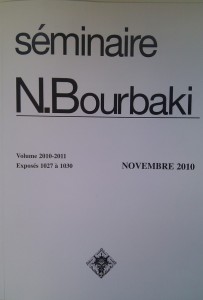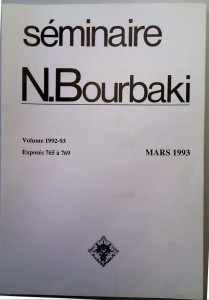In the current rapid development of “sieve in orbits”/”affine linear sieve”/”sieve in expansion”, as surveyed in my (upcoming) Bourbaki lecture, one is concerned with working with a finitely generated subgroup

and one is led to consider its Zariski closure G, in the ambiant special linear group (the relevance of G is due to the fact that it turns out to control the image of Γ modulo almost all primes — a rather surprising fact, at first sight, which is due largely to work of Nori, Matthews-Vaserstein-Weisfeiler, Weisfeiler, Hrushovski-Pillai, in various degree of generality).
Together with G, which is seen as an algebraic group over the rationals, comes the corresponding arithmetic group

which contains the given discrete group.
A basic dichotomy, already emphasized in the paper of Bourgain, Gamburd and Sarnak, is between the case where (1) Γ has finite index in Γa; or (2) this index is infinite.
The first case applies, obviously, to Γa itself, and simple examples of the second are the “Apollonian group” that controls Apollonian circle packings (as explained, for instance, in this lecture by Sarnak) or the subgroup of SL2(Z) generated by the matrices

an example popularized by Lubotzky (the point being that if the two 3 are replaced by two 1 or two 2, the corresponding group is in the finite index situation).
The distinction according to the index is natural and crucial: for instance, if the Zariski closure is SLm itself, and m is at least 3, it follows that Γ has Property (T) of Kazhdan, and that immediately gives the crucial expansion properties of the congruence quotients, which are fundamental in the applications to sieve.
Now, here is the terminological rub: Bourgain, Gamburd and Sarnak suggested to call the second case (infinite index) the “thin” case, and the corresponding discrete groups, “thin” subgroups of Γa. The terminology is appealing, and it is unfortunate that it clashes with an earlier definition of “thin” sets of (rational points of) algebraic varieties, which appears, for instance, in Serre’s book “Topics in Galois theory” (see Chapter 3). (A standard example of an infinite but thin set of integers is the set of squares; the primes, on the other hand, are not thin.)
This notation clash is problematic in a few ways. For instance, a “thin” subgroup (one with infinite index in the corresponding arithmetic group) is not a thin subset of

More annoyingly, a basic sieve fact that comes out of the expansion setting (when applicable) is that the subset of Γ where a function f takes integral values with few prime factors can be proved to not be thin (in the sense of Serre), even in the second “thin” case (infinite index). This is a nice qualitative measure of the fact that such such sets with “almost prime” values remain quite large, but as stated, there are too many thins in this sentence…
What to do? In French, it has been suggested by someone (during the conference on exponential sums that just ended here in Zurich, and hopefully I will remember who it was soon) to speak of “un sous-groupe fin” (in contrast with “un ensemble mince”, which is the established translation for the “thin” sets of Serre’s book). This sounds fine to me, but it’s not clear how to adapt that to English. A “fine subgroup” is not the right translation; in fact, I would typically translate (in a pastry context) “une tarte fine” with “a thin pie”. So I am rather scratching my head… Does anyone has a suggestion?


![[GANT poster]](http://blogs.ethz.ch/kowalski/files/2010/10/gant-general-211x300.jpg)
![[GANT Poster]](http://blogs.ethz.ch/kowalski/files/2010/10/gant-school-211x300.jpg)